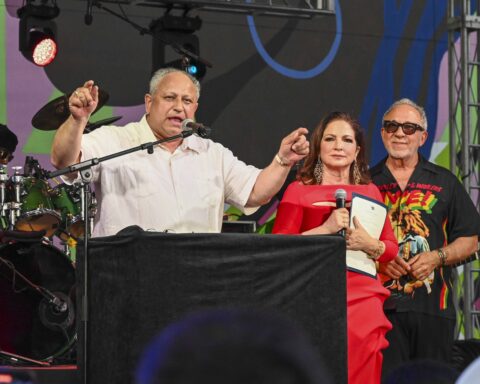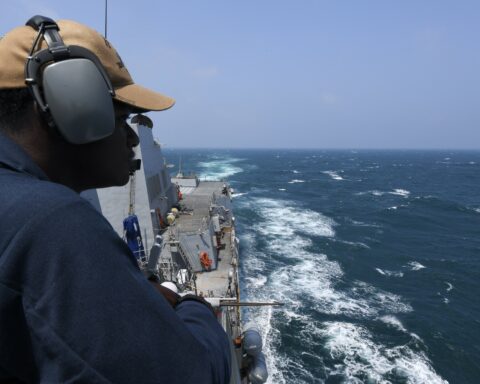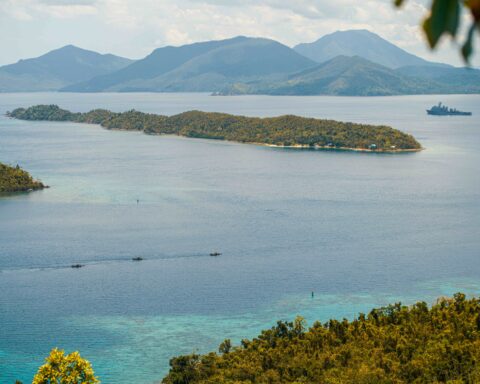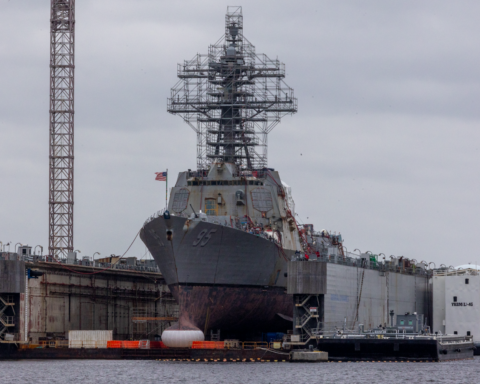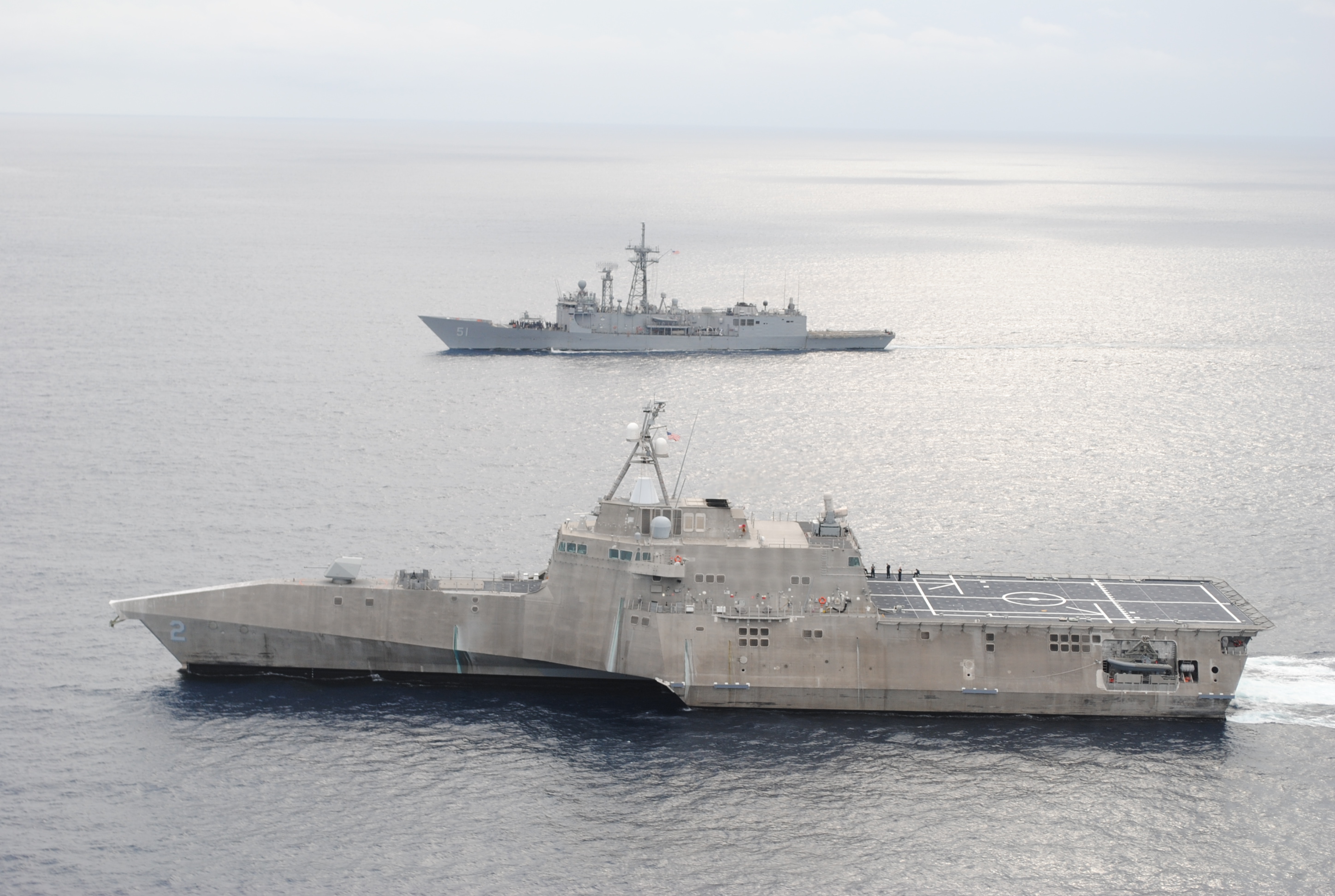
WASHINGTON, D.C. — The Program Executive Office for Littoral Combat Ships (PEO LCS) is working with both its shipbuilders to determine how to bring the current LCS designs into a more lethal and survivable frigate design, while it works with other Navy offices to finalize the frigate requirements.
The Navy decided the last 20 of its 52 LCSs would instead be a modified LCS, later renamed a frigate. Though many details are still being worked out, PEO LCS Rear Adm. Brian Antonio told USNI News in an interview at Washington Navy Yard that the frigate will be an LCS, plus more guns, a multi-functioned towed array for submarine detection, over-the-horizon radar and a light-weight torpedo countermeasure, plus the potential to add “capability enhancement” packages – either a 30mm gun and rigid-hull inflatable boats for visit, board, search and seizure missions, or additional sonars.
The program office is also working with the Navy’s Surface Warfare Directorate, Naval Surface Warfare Center Dahlgren, Program Executive Office for Integrated Warfare Systems and more to refine the frigate requirements and clearly document them. The Navy will need to work through how to integrate new systems into the combat management system, what hull, mechanical and electrical changes may be needed, how many people will be part of the core crew of the ship, and more.
Antonio said the requirements will be finalized “this year, as soon as we can.”
Surface warfare director Rear Adm. Peter Fanta will lead a series of requirements resource review boards for the frigate, the first of which will look at the combat management system and upgraded over-the-horizon radar, Antonio said.
“We’ll get into what the requirements are for those, and then that will sort of free us up [for] getting into the design work,” he said, adding that would happen “in a matter of weeks as opposed to months.”
The Small Surface Combatant Task Force estimated it would cost about $75 million more per frigate than LCS, Antonio said. The current LCS is about $100 million less per ship than the congressional cost caps, so he said he was confident the small surface combatant portion of the fleet would remain affordable.
One big question looming is whether both LCS designs – a monohull by Lockheed Martin and a trimaran by Austal USA – will move into the frigate program or if the Navy will downselect to one variant. Antonio said all options are being kept open at the moment, but he noted the advantages of keeping both designs in production.
“I have said as PEO, there are great advantages for competition,” he said.
“It provides the opportunity to make sure that we benefit from competition. I think industry actually benefits from competition, it keeps pencils sharp.”
To keep all options open, Antonio said his office has established contractual relationships with both shipbuilders to look at the LCS-to-frigate transition.
“We haven’t set an acquisition strategy in place that says we’re going to continue to build equal numbers of the variants going into the future, but we want to keep that option open as we get closer to FY ‘19,”Antonio said.
“So we’re working with both shipbuilders, saying, what do we need to do to each variant to make these changes to turn it into a frigate based on what the decisions were that came out of the secretary of defense?”
By 2019, when the Navy will need to issue its first frigate contract, two of each variants of LCS will be in Singapore, so the fleet will have the opportunity to provide feedback ahead of a contract decision. Though the sailors operating the ships won’t have the final say in the matter, “they’ll have a say in how the requirements go,” Antonio said.
Once the frigate requirements are set and design work begins, Antonio said he also expects some upgrades may work their way into the Fiscal Year 2017 and 2018 LCSs. The acquisition strategy for those years is not finalized yet, but “what we anticipate doing is combining those two years so we only have to do one solicitation. And we’re still coming through what that RFP [request for proposals] will look like and the overall acquisition strategy. We owe [Navy acquisition chief Sean] Stackley an acquisition strategy approach and will get that approved through the proper chains and be able to come out with an RFP in late 2016 timeframe so we can negotiate an award in ’17.”
In designing the RFP, Antonio said “we have opportunity to say, hey shipbuilders, we eventually want to incorporate as much of the frigate attributes back into LCS over time. We have an opportunity with those last six LCSs, if we’ve got high capability impact, low-cost changes that we can incorporate – armoring, weight reduction, configuration changes where they make sense and still retain the modularity – then let’s go ahead and get those priced in, and if we can afford it we’ll go do it.
“And then what that does, it has several advantages. One is, it gets the shipyard ready in terms of a learning-curve effect, it gets them ready to incorporation of the frigate when we award frigates, regardless of which shipbuilder it is, or both shipbuilders. …. For us, as we come to negotiations and awarding for the ’19, now we have actual return costs on some of these, so we both know across the aisle what some of these changes may cost. So that’s an affordability aspect that’s sometimes lost on people as we move forward.”
For the existing LCS hulls, Antonio said the Navy would look at taking out weight or adding in armor during post shakedown availabilities or other yard maintenance periods to help close the gap between the LCS and the frigate.
Also awaiting final requirements is a decision on which over-the-horizon missile to use on the frigate. Asked about a timeline for the decision, Antonio said “the first thing we need to do is get the requirements set from the Pentagon.”
Given time constraints, he said he was not interested in any kind of development effort; rather, the missile he picks will be a system of record in the U.S. Navy, a system used in other navies or one that industry has matured and could easily integrate with the frigate.
“The advantage of an over-the-horizon missile, though, is undeniable,” he said, saying the fleet has asked for it and it has proven itself in several wargames.
“It’s going to be successful, it’s just a matter of getting the requirements set down, taking a look at what material solution can meet that requirement, and then looking at the integration piece onto the ship,” Antonio said.


